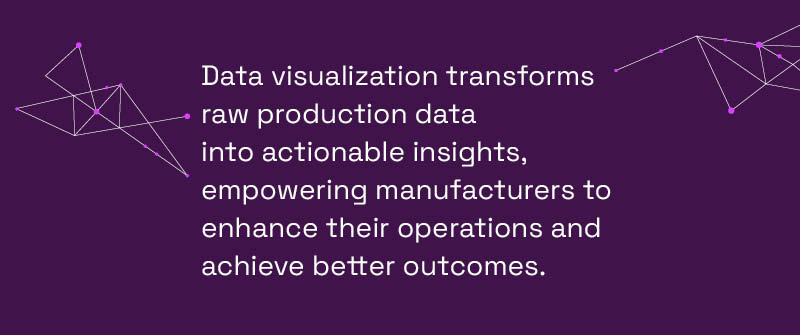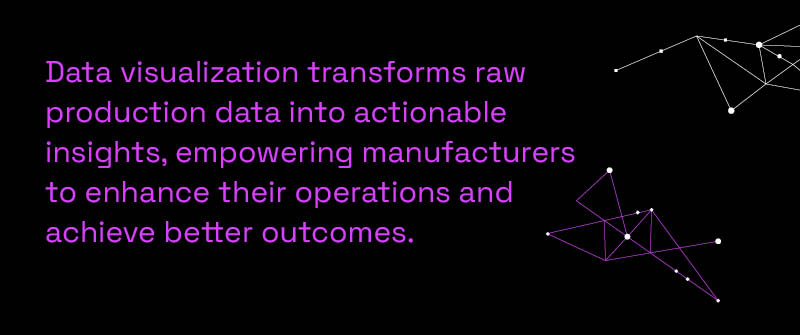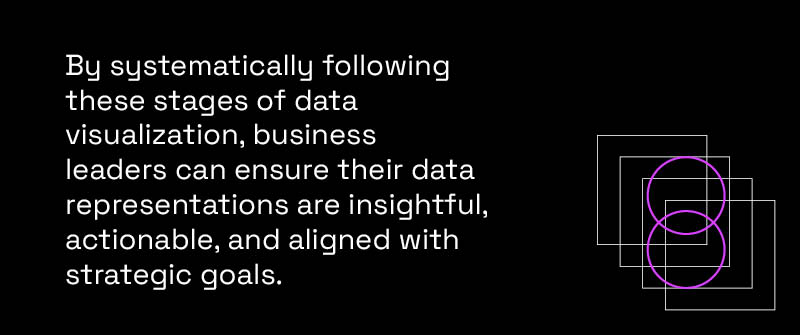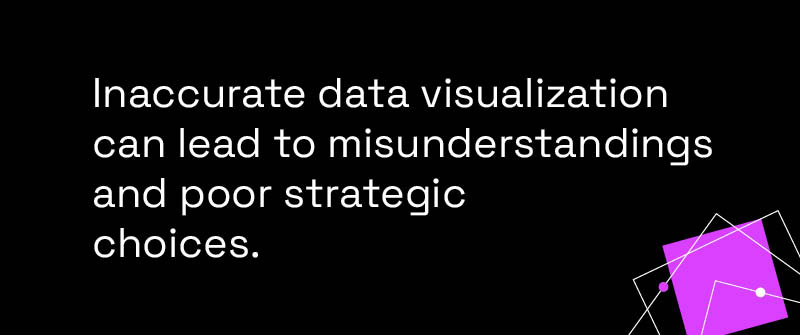
What is Manufacturing Data Visualization?
Manufacturing data visualization is the process of transforming complex data into a visual representation, making it easier to understand and analyze. This technique is crucial in the manufacturing industry, as it enables plant managers and operators to make informed decisions, identify trends, and optimize production processes. By leveraging data visualization tools, manufacturers can gain actionable insights from their production data, leading to improved efficiency, reduced costs, and increased productivity.
In manufacturing, the ability to quickly interpret and act on data is paramount. Data visualization tools, alongside manufacturing data analytics, provide a clear and concise way to present production data, allowing stakeholders to grasp complex information at a glance. This visual representation of data not only aids in immediate decision-making but also helps in long-term strategic planning, ensuring that manufacturing operations are both efficient and effective.
What are the key components of effective data visualizations?
Effective data visualizations in manufacturing are built upon several key components that enhance their clarity, usability, and impact. These components include:
Clear and Concise Data Presentation
Ensuring that the data is presented in a straightforward manner, free from unnecessary complexity.
Relevant and Timely Data
Providing data that is up-to-date and pertinent to the current manufacturing processes.
Ability to Drill Down into Detailed Information
Allowing users to explore deeper levels of data for more granular insights.
Customizable Dashboards and Visualizations
Offering flexibility to tailor visualizations to specific needs and preferences.
Real-Time Data Updates
Ensuring that the data is continuously updated to reflect the current state of manufacturing operations.
By incorporating these components, manufacturers can create data visualizations that provide a comprehensive view of their production processes, enabling them to make data-driven decisions and drive operational improvements.
What Are the Benefits of Data Visualization Dashboards in Manufacturing?
The benefits of data visualization in manufacturing are numerous. Some of the most significant advantages include:
Improved Decision-Making
Data visualization tools provide plant managers and operators with real-time insights into production processes, enabling them to make informed decisions quickly.
Enhanced Operational Efficiency
By identifying trends and patterns in production data, manufacturers can optimize their processes, reduce waste, and improve productivity.
Increased Productivity
Data visualization helps manufacturers to identify areas for improvement, streamline their processes, and reduce downtime.
Better Quality Control
Data visualization enables manufacturers to track quality metrics in real time, identify defects, and take corrective action to improve product quality.
In essence, data visualization transforms raw production data into actionable insights, empowering manufacturers to enhance their operations and achieve better outcomes.

How Is Data Analytics Used In Manufacturing?
Data analytics has become a game-changer in the manufacturing industry. By harnessing the power of data, manufacturers can transform their operations, enhance productivity, and drive competitive advantage.
Optimizing Production Process
One of the primary ways data analytics is used is in optimizing production processes. Through the analysis of machine performance, workflow efficiency, and resource utilization, manufacturers can identify bottlenecks and opportunities for improvement. This leads to significant reductions in downtime and operational costs while increasing overall output.
Predictive Maintenance
Another critical application is predictive maintenance. Traditional maintenance strategies are often reactive and can lead to unexpected equipment failures, causing costly downtime. By utilizing data analytics, manufacturers can monitor the condition of machinery in real-time, predict potential failures before they occur, and schedule maintenance at optimal times. Machine data plays a crucial role in this process by providing real-time insights into machine performance and quality control, enabling manufacturers to make informed decisions and drive operational improvements. This proactive approach ensures higher equipment availability and extends the lifespan of critical assets.
Quality Control And Assurance
Data analytics also plays an essential role in quality control and assurance. By analyzing production data, manufacturers can detect anomalies and deviations from established quality standards. This enables immediate corrective actions, ensuring that products meet stringent quality requirements and reducing the risk of defects and recalls.
Supply Chain Management
In addition, data analytics is vital for effective supply chain management. It provides manufacturers with insights into supplier performance, inventory levels, and demand forecasting. With this information, manufacturers can optimize their supply chain operations, reduce lead times, and improve customer satisfaction.
The Shift To Digital Data In Manufacturing Analytics
The manufacturing industry has undergone a significant transformation in recent years, shifting from manual data collection and analysis to digital systems. This shift has been driven by technological advancements, such as the Industrial Internet of Things (IIoT), advanced computing, and data analytics for inventory management. The use of digital data in manufacturing has enabled plant managers and operators to collect, analyze, and visualize data in real time, leading to improved decision-making, increased productivity, and enhanced operational efficiency.
The transition to digital data has revolutionized the way manufacturers operate. With the advent of data visualization tools, manufacturers can now create visual representations of their production data, making it easier to understand and analyze. This has led to a significant improvement in the way manufacturers operate, enabling them to make data-driven decisions, optimize their processes, and improve product quality.
Digital data and visualization tools have also facilitated the integration of various data sources, providing a holistic view of manufacturing operations. This comprehensive perspective allows manufacturers to identify inefficiencies, predict potential issues, and implement proactive measures to enhance overall performance. As a result, the shift to digital data has not only streamlined manufacturing processes but also paved the way for continuous innovation and improvement in the industry.
What Are The Four Types Of Data Visualization Tools?
Understanding the types of data visualization is crucial for effectively leveraging data to make informed business decisions. In the dynamic field of manufacturing, leveraging the correct type of visualization can turn raw data into actionable insights, driving efficiency and productivity. A manufacturing dashboard plays a pivotal role in this process by providing real-time access to critical data, enabling plant managers to make informed and timely decisions.

Bar Charts and Histograms
Bar charts and histograms are fundamental types of data visualization used to represent categorical and numerical data. In manufacturing, these visual tools can be employed to monitor production line performance, compare output across different shifts, or even analyze defect rates. Integrating production metrics into these dashboards is crucial for tracking materials, identifying bottlenecks, and optimizing workflows. Bar charts help identify trends and pinpoint areas that require improvement, providing a clear and concise view that supports quick decision-making processes.
Pie Charts and Donut Charts
When it comes to showing proportions, pie charts and donut charts are effective tools. These charts are perfect for illustrating the contribution of various categories to a whole. In a manufacturing context, these charts can be used to break down the share of different product lines in overall production or to visualize the distribution of resources across different departments. These visualizations are effective for high-level summaries that yield immediate insights into proportion-based data.
Line Graphs
Line graphs are indispensable for showcasing trends over time. In the world of manufacturing, they can be used to track performance metrics such as production volume, downtime, and cost over specific periods. Line graphs provide clarity on how these metrics change, helping to identify seasonal trends or the impact of specific interventions. Integrating real-time data access and analytics into the manufacturing process is crucial for optimizing operational performance and supporting strategic decision-making. This long-term perspective is invaluable for robust strategic planning and continuous improvement.
Scatter Plots
Scatter plots are powerful for identifying relationships between two variables. In a manufacturing setting, scatter plots might be used to explore the correlation between machine run time and output or the relationship between employee hours and defect rates. These plots help in spotting anomalies and correlations that may not be immediately obvious, offering deeper insights that can guide process optimization and resource allocation.
Ultimately, each type of data visualization serves a unique purpose, and selecting the right one depends on the specific insights you aim to uncover. By mastering these data visualization techniques, leaders in manufacturing can transform complex datasets into clear, compelling narratives that drive actionable strategies.
1
What Are The 7 Stages Of Data Visualization?
Understanding the seven stages of data visualization is critical for business leaders aiming to harness the full potential of their data. Effective data visualization not only aids in comprehension but also drives strategic decision-making.
1. Data Collection
The journey begins with collecting relevant and high-quality data. This stage involves gathering data from various sources, such as sensors, transactional databases, or external datasets. Ensuring the data’s accuracy and relevance is vital to avoid misleading visualizations.
2. Data Cleaning
Once collected, the data needs to be cleaned. This stage entails filtering out inaccuracies, correcting errors, and handling missing values. Proper data cleaning ensures that the data you visualize is reliable and accurate.
3. Data Analysis
After cleaning, the data is ready for analysis. This stage involves using statistical methods and algorithms to extract meaningful patterns and insights from the data. Effective analysis transforms raw data into valuable knowledge.
4. Data Modeling
Data modeling is the process of creating data structures that organize the data in ways that facilitate analysis. This can involve creating databases, building data warehouses, or designing specific data architectures tailored to visualization needs.
5. Visualization Design
This stage is crucial as it deals with selecting the right visualization techniques to represent the data insights. Choices here include deciding on appropriate chart types (bar, pie, line, scatter plots) and considering the audience’s needs for clarity.
6. Implementation
Once designed, the visualization needs to be implemented using software tools such as Power BI, Tableau, or custom-built solutions. This involves developing interactive dashboards and reports that can be easily interpreted by stakeholders. Manufacturing dashboards play a crucial role in visualizing and tracking real-time performance within manufacturing processes, enhancing decision-making, monitoring production efficiency, and providing a centralized view of machine and production data.
7. Review and Iteration
The final stage is a continuous process of reviewing and refining the visualizations. Gathering feedback and making iterative improvements ensures that the visualizations remain relevant and valuable over time. This stage helps in adapting to changing business needs and technological advancements.
By systematically following these stages of data visualization, business leaders can ensure their data representations are insightful, actionable, and aligned with strategic goals.

What Are The 4 Pillars Of Data Visualization?
Understanding the fundamental principles or pillars of data visualization is critical for leveraging the full potential of your manufacturing data. These pillars form the backbone of effective data visualization and can significantly enhance decision-making processes.
Clarity
The first pillar, clarity, emphasizes the importance of presenting data in a way that is easily understandable and interpretable. In a manufacturing context, this could mean using straightforward visual tools like bar charts or line graphs to demonstrate production trends. When data is clear, it fosters better communication and allows stakeholders to make informed decisions swiftly. Clarity eliminates ambiguity and ensures that complex data is accessible and actionable.
Accuracy
The second pillar is accuracy. This pillar ensures that the data presented is precise, which is essential for maintaining trust and making reliable business decisions. Inaccurate data visualization can lead to misunderstandings and poor strategic choices. For manufacturing leaders, accuracy in data visualization means presenting exact error rates, output volumes, and downtime statistics, which are crucial for process optimization and quality control.

Efficiency
The third pillar, efficiency, focuses on how quickly and effectively the data can be interpreted and used. Efficient data visualization saves time by highlighting key insights at a glance, thus supporting swift decision-making. In manufacturing, this might involve dashboard designs that provide real-time updates on machine performance, inventory levels, or labor efficiency. Efficiency in data visualization ensures that information is not just accessible but also actionable, driving improvements in operational performance. Production dashboards play a crucial role in visualizing and monitoring manufacturing processes by providing real-time data on production lines, helping operators track key performance indicators (KPIs), and make informed decisions to optimize efficiency and address operational challenges.
Aesthetics
The fourth and final pillar is aesthetics. While this may seem secondary to the other pillars, aesthetically pleasing data visualizations can significantly enhance user engagement and retention. In the manufacturing industry, well-designed visualizations that incorporate company branding and use color effectively can make reports and dashboards more engaging, helping stakeholders to better grasp and remember key insights.
Integrating these pillars of data visualization into your manufacturing processes can transform raw data into powerful visual narratives that drive strategic decisions.
Empower your manufacturing intelligence with P3 Adaptive. Our customized solutions and expert consultants will convert your most complex data into clear, accurate, and actionable visualizations, enabling you to make swift and strategic business decisions with confidence. Contact P3 Adaptive today!
Get in touch with a P3 team member